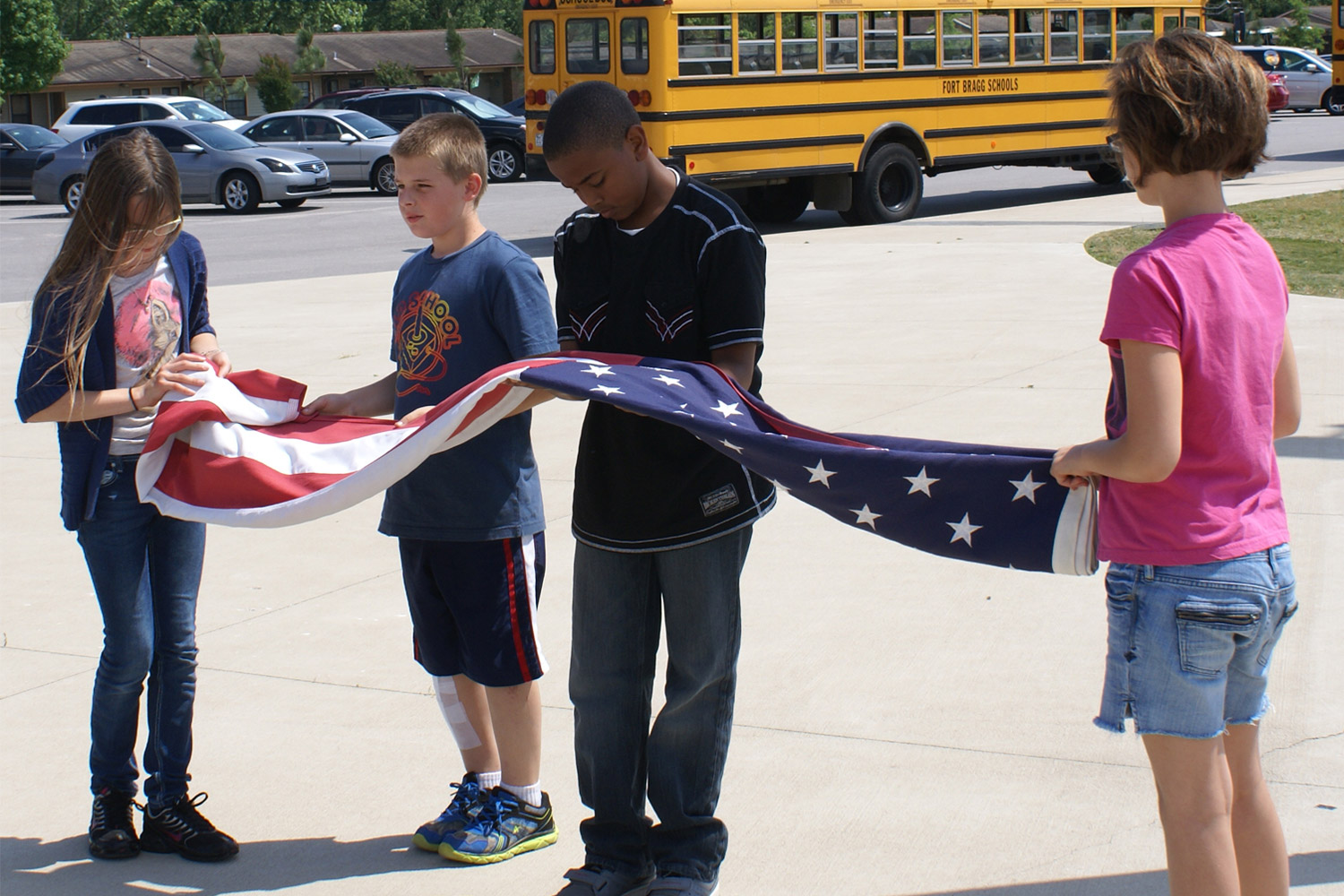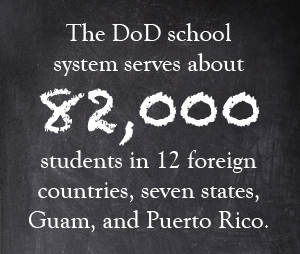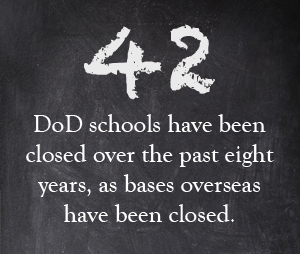©WAMU 88.5 All Rights Reserved
Contact | Privacy Policy | Terms of Use
— a public media initiative to address the drop out crisis,
supported by the Corporation for Public Broadcasting.

Most military children go to public schools, but a small percentage — approximately 82,000 in all — attend schools run by the Department of Defense Education Activity, commonly referred to as DoD schools.

There are 180 of them across the United States and scattered around the world. These schools are little known to the public, but they may have important lessons to offer for the education system as a whole.
More than 40 of these Department of Defense schools have been shuttered over the past eight years. One of the main reasons is that U.S. bases built overseas during the Cold War have been closed.
An investigative report by The Center for Public Integrity found three out of every four school buildings need extensive renovation or are beyond repair.
Despite these challenges, Department of Defense schools boast high test scores, have high graduation rates and are very popular with military families who make use of them. Many choose to live on base just so their children can attend these schools.
On the 2013 National Assessment of Educational Progress test, often referred to as the nation’s report card, DoD schools did better on average than public schools on both reading and math tests for fourth and eighth graders. And in reading, DoD students in both grades score at the same level as the top performing states in the nation.
So how do they do it?
Members of Congress were wondering the same thing. So in 2000, they asked Claire Smrekar, an associate professor of public policy and education at Vanderbilt University, to investigate. She spent a year traveling to Department of Defense schools, from Western Europe to the southern United States to Okinawa, Japan, to produce her report.
When Smrekar began her research, she expected an easy explanation for the high test scores.
“I thought it was going to have to simply do with military discipline and kind of strict governance, and we found there was so much more complexity,” Smrekar says.
Military children have at least one parent who is working, for starters. They also have safe, stable housing and health care.
But Smrekar found there are also challenges. Approximately one-third of military children move every year because a parent is transferred and 45 percent of students in U.S. DoD schools are low-income.
Smrekar says the DoD system’s long-term philosophy in education is very different from the “flavor of the day” type of reform efforts you sometimes see in public schools.
“The commitment to the long term is a clear, distinctive and unusual quality we don’t see in civilian school systems. Part of that is because they are somewhat politically-insulated and they are not subject to the political whims or rhetorical wars that civilian schools are sometimes subjected to,” Smrekar says.

But she also says the Department of Defense schools’ success starts with strong, effective teachers.
At Irwin Intermediate, an elementary school in Fort Bragg, North Carolina, just one of the school’s 50 teachers is new. Many of the teachers have been at the school for decades — something not often seen anymore at non-military schools.
Teachers rarely leave the DoD system — 70 percent of DoD teachers have 11 or more years of experience — and a big reason for that is because the pay and benefits are much better than in surrounding civilian schools.
“This is my 29th year of teaching and my 17th year at Fort Bragg,” says Deborah Bailey, who teaches third grade. “If I went back to the county now, I would take over a $30,000 pay cut. It’s probably closer to $40,000.”
At DoD schools, the curriculum, textbooks, online resources and graduation requirements are the same, no matter where you live. All military schools have started adopting the Common Core standards, making it easier for military children who move every two to three years.
Otherwise, Smrekar says superintendents and principals operate fairly independently, and that kind of autonomy is often compared to how charter schools operate. But unlike charter schools, military schools have teachers unions. And union officials and school leadership actually seem to appreciate their respective purposes.
Vera Morgan represents 350 teachers at Fort Bragg.
“It’s a great give and take from both of us,” Morgan says. “We communicate. If you talk, you find you can solve the problems; you don’t have to file a grievance.”
Another reason for the success of Department of Defense schools is that the system is well-funded. According to one study, students in DoD schools receive nearly 20 percent more funding for each student compared to traditional public schools.
Principal Ginny Breece says nearly 80 percent of children at her school are low-income, but she gets a lot of help to support those students, including specialized staff.
“I’ve got two full-time counselors at Irwin, I’ve got a full-time nurse, I’ve got a speech therapist, an occupational therapist,” Breece says. “We probably have 20 percent of kids on special education and we have a lot of resources to support those kids.”
Mary Ellen Cravotta, who has worked in military schools for 38 years, says their access to resources is reflected in the breadth of their library.
“Look at this facility, is this not beautiful?” Cravotta says. “I have spent over $20,000 just this year on books and DVDs. Our resources are unlimited.”
Cravotta says they have more than 15,000 books in their library — that’s two and a half times more books than the average public school library per student.
She also says certain aspects of DoD schools are standardized and that makes it easier for children who move frequently because of their parents’ assignments.
“When they look up a book online if they’re in Japan, if they’re in Fort Campbell, Kentucky, if they’re in West Point, wherever they are, the curriculum is the same, the textbooks are the same, online resources are the same,” Cravotta says.
Ginette Pena is a teacher’s aide and a parent whose three boys attend Irwin Intermediate. She and her husband, a service member of 22 years, moved on base so their children could attend the school.
“My husband has been deployed to Haiti, to Bosnia, to Iraq, Afghanistan, he’s been to Korea, he’s been on many trainings,” Pena says.
He has also missed half of his 12-year-old son’s birthdays.
“My son would go to school and he would say his stomach was hurting and he started laying down a lot on the floor. And I said, ‘Yeah I don’t know why he’s doing that, I really don’t,’” Pena says. “The counselors at the schools that were telling me, ‘This is classic. They’ll just say their stomach hurts or they’ll need time to lay down.’”
Pena says her husband found out recently that he was being deployed again soon. Coping with that news takes its toll on the family.
“The first thing my son said, ‘You’re going to miss my birthday again, huh?’ so he knows. And we try to just do what we have to do; make the best of our situation,” Pena says.
Pena says school staff included her son in a special “lunch bunch” for children of deployed service members. They gave him a journal and little stuffed toys. She’s grateful that as the family prepares for big changes at home, her sons’ school will remain a source of stability in their lives.
That sense of togetherness can also be found at Quantico Middle/High School, a Department of Defense school in Northern Virginia. The base is known as the “Crossroads of the Marine Corps,” because there are so many military training and educational institutions there.
That’s where 16-year-old Destiny Oakley sits outside in the sunshine at the Junior Reserve Officer Training Corps shooting range.
“I have a couple friends here who are in ROTC so they would say, ‘Oh we’re shooting today.’ And I was like, ‘What?’” Oakley says. “They have to shoot the targets and they get scored on it and its part of their grade and they get medals. I would have never thought that schools teach kids how to properly shoot a gun.”
That’s just one of the ways this school is different from a public school. It’s also much smaller.
“I came from a public school where my sophomore class was 300 students and now I have 30 in my junior class,” Oakley says.
There are some downsides to a small school. Students here wish there were more elective classes offered and that the dating pool wasn’t so tiny. But overall, they say they feel a sense of togetherness and belonging that was missing when they studied off base.
What adds to that sense of community is that most teachers have either served in the military or had a family member who served. Robert Hume was an Army officer for 14 years, so he understands what military children go through.
“If you walked into my classroom and you asked the kids, ‘How many of you know somebody who’s served in combat?’ Every hand would go up. And if you asked them how many of them knew somebody that was either wounded or killed in combat, every hand would go up again. You’re not going to find that in public school,” Hume says.
Teachers recognize the signs that a student is struggling — whether those signs are loud outbursts or sleeping in class. They have time to get to know each child. And they are flexible, giving final exams early if students are moving, allowing them to make up work if they take time off before a parent deploys, and letting children write letters in class to their absent parents.
Destiny Oakley says the level of understanding is very different from her previous school.
“I said, ‘Well I’m not going to be at school my dad’s coming home. He’s been gone for like eight months.’ And they’re like, ‘Well can’t you just wait to see him?’ or ‘Do you really have to miss school?’” Oakley says. “The school just counts it as if you skipped school almost. Whereas teachers here are kind of like, ‘Oh your dad’s coming home, so that’s why you’re not going to be here.’ And that’s completely fine, that’s excusable.”
These schools, which report to the Secretary of Defense rather than the Secretary of Education, seem to be relatively insulated from some of the most persistent problems facing civilian schools, such as the achievement gap between white and black students.
While DoD schools are exempt from the requirements of No Child Left Behind, DoD officials say the national figures show the black-white achievement gap is significantly less than the national rate. The principal at Quantico Middle/High, Michael Johnson, doesn’t even track data on that gap in his school.
“We try to make sure in our school, we pay a lot of attention to each individual student. So we are already attacking the gaps as a daily matter of routine,” Johnson says. “At this point, our students are achieving so high that we don’t recognize any major gaps.”
In AP exams, black students at these schools outperform their peers nationally.
Researcher Claire Smrekar says these attitudes go back to the 1950s, when military installations led the way in desegregating schools.
“We have always argued that the school system was really the first system to — intentionally and carefully and systematically — racially integrate their schools, particularly in the southeast, because they knew they could not have a racially-integrated military if the children of their military members attended racially-segregated schools,” Smrekar says.
She says that while the military culture of racial integration may not be perfect, it still sets the standard for a culture of high expectations for everyone, regardless of race.
“The way in which a military man or woman moves through the military through a very objective set of tests and requirements, I think does carry over to a system of fairness, a system of high expectations and a culture of opportunity,” Smrekar says.
And the secret ingredient to the DoD school system’s success, says Michael Johnson, is the level of involvement of military parents.
“Parental involvement is huge with a capital H. That is a teacher’s heaven! I think that’s the critical piece,” Johnson says.
For service members, the more schools you attend and the more training you receive, the more you get promoted. And Smrekar says that culture of education is part of the fabric of military life from the top down. She asked principals about their typical attendance for PTA conferences.
“And they looked at each other and said, ‘Well, 100 percent of course’ because the military command ensure that all military service members have time and make time to walk over and talk to their children’s teachers,” Smrekar says.
Daily attendance at this school is around 94 percent. Quantico’s Assistant Principal, Daniel Mulhern, says discipline issues in his high school are almost “nonexistent.”
“Behavior is not even on the radar,” Mulhern says. “This year as an example, I had 10 disciplinary concerns this entire year and I’m talking minor disciplinary concerns. That’s it.”
Those include students who came late to school, talked in class, and had a cell phone ring during a lesson. In seven years, there has only been one fight. Mulhern says the accountability factor in the military helps. That means students’ parents can get into trouble if they misbehave. It’s what some experts call a punishment “powerful in its potential to be used,” not in actually using it.
“When I have to call the parents I always have full support and there’s never been a ‘you are picking on my son or daughter.’ It’s ‘we got it, Mr. Mulhern. We’re gonna take care of it, we’ll have a discussion with our son or daughter this evening,’” Mulhern says.
The future of military schools is an open question.
The Pentagon has commissioned the RAND Corporation, a think tank, to look at how it can best balance cost and quality at 60 Department of Defense schools in the U.S. Each one will be looked at independently, and while some schools may see no changes, others could be closed or turned into charter schools. The report is expected this fall.
Back outside in the sunshine, on Quantico Middle/High School’s shooting range, students Jannely Negrete, Emily Sanborn and Destiny Oakley aren’t thinking about schools closing down. They’re thinking of graduation and life after.

“My military experience is definitely influenced our family. My brother is at the Naval Academy right now and my older sister is at the Air Force Academy,” Sanborn says. “But, for me personally, I don’t enjoy moving around all the time, even though I’m very thankful for my experiences. But that being said, its, there’s a good chance that I could marry into the military. Just because I was born and raised hardcore Marine kid.”
Asked what the civilians can learn from military children, the three are circumspect. They say people can learn to take pride in their nation. The sacrifices they have seen friends and family make ensure they never take their freedom for granted.
“You may have friends who are not military who say, ‘Ugh I don’t want to go to my grandma’s house for Christmas or Thanksgiving.’ It just almost seems like a pain to them, but I don’t even remember spending a Thanksgiving with any of my distant family, it’s always just my mom, my dad, and me and my brother,” Oakley says.
Her dad missed her birth, for instance, so when she hears others complain about their families, she knows she won’t take hers for granted.
“I think that’s something that, maybe, military kids understand more about cherishing every moment that you do have, because you don’t know what moments you might not have together.”